Are Essential Oils Safe for Dogs Skin
Curious about using essential oils for your furry friend?
We explore what essential oils are, how they can be beneficial for dogs, and whether they are safe for your pet’s skin.
We discuss the potential risks of using essential oils on dogs, the most common oils that are safe for dogs, and how these oils can help with skin conditions.
We cover alternative remedies, precautions to take when using essential oils, and what to do if your dog has a negative reaction.
Let’s dive in!
Key Takeaways:
What Are Essential Oils?
Essential oils are highly concentrated plant extracts that retain the natural aroma and flavor of their source. They are commonly used in aromatherapy for both humans and dogs due to their therapeutic properties.
These oils are obtained through a process called distillation, where the plant material is heated, and the steam is collected and condensed to separate the oil. Other methods include cold pressing for citrus oils and solvent extraction for delicate flowers.
Regarding applications, essential oils have a wide range of benefits. For humans, they are used to alleviate stress, improve sleep quality, aid digestion, and even boost immunity. In dogs, essential oils can help with anxiety, skin irritations, joint pain, and more, making them a versatile tool in holistic pet care.
How Are Essential Oils Used for Dogs?
Essential oils for dogs are commonly used by holistic veterinarians and pet owners for various purposes, including aromatherapy, skin treatments, and emotional well-being.
One of the most common ways to use essential oils for dogs is through diffusion. Simply adding a few drops of a pet-safe essential oil to a diffuser can help create a calming environment for your furry friend.
Additionally, topical application involves diluting essential oils with a carrier oil and applying them to your dog’s skin. This method can be useful for skin conditions or soothing muscle discomfort. It’s important to note that ingestion of essential oils should only be done under the guidance of a holistic veterinarian to ensure safety.
What Are the Benefits of Using Essential Oils for Dogs?
Using essential oils for dogs can have potential benefits such as promoting relaxation, repelling fleas and ticks, reducing anxiety, and supporting skin health. Lavender oil, among other essential oil brands, is commonly used for its calming properties.
Regarding promoting relaxation in dogs, lavender oil is a great go-to choice. Its soothing aroma can help create a sense of calm for anxious or stressed pups. Certain essential oil blends specifically formulated for dogs, like a calming blend with lavender, chamomile, and frankincense, can be applied topically or diffused to create a peaceful environment.
Aside from relaxation, several essential oils have natural properties that can act as potent flea and tick repellents for dogs. Oils like peppermint, cedarwood, and lemongrass are effective in deterring these pests, making them a safer alternative to chemical-laden products.
Are Essential Oils Safe for Dogs Skin?
When used properly and in correct dosages, essential oils can be safe for dogs’ skin and offer various benefits such as soothing irritations, supporting healing, and maintaining coat health.
It is crucial to remember that essential oils are highly concentrated substances and should never be applied to a dog’s skin undiluted. Proper dilution ratios are essential to prevent skin irritation and adverse reactions. A common guideline is to dilute essential oils with a carrier oil, such as coconut or olive oil, at a ratio of 1-2 drops of essential oil per 1 ounce of carrier oil.
Before applying any new essential oil to your furry friend, it is advisable to conduct a patch test. This involves applying a small amount of the diluted oil to a small area of the dog’s skin and monitoring for any signs of irritation or sensitivity.
While essential oils can offer benefits, it is important to monitor your dog closely for any adverse reactions after application. If you notice any redness, itching, swelling, or other unusual symptoms, immediately stop using the lemon oils safe for dogs and consult a veterinarian.
When choosing pet-safe essential oils for topical applications, always opt for oils that are known to be safe for dogs, such as lavender, chamomile, or frankincense. Avoid oils that are toxic to dogs, like tea tree oil, which can be harmful if ingested or applied undiluted to the skin.
What Are the Potential Risks of Using Essential Oils on Dogs?
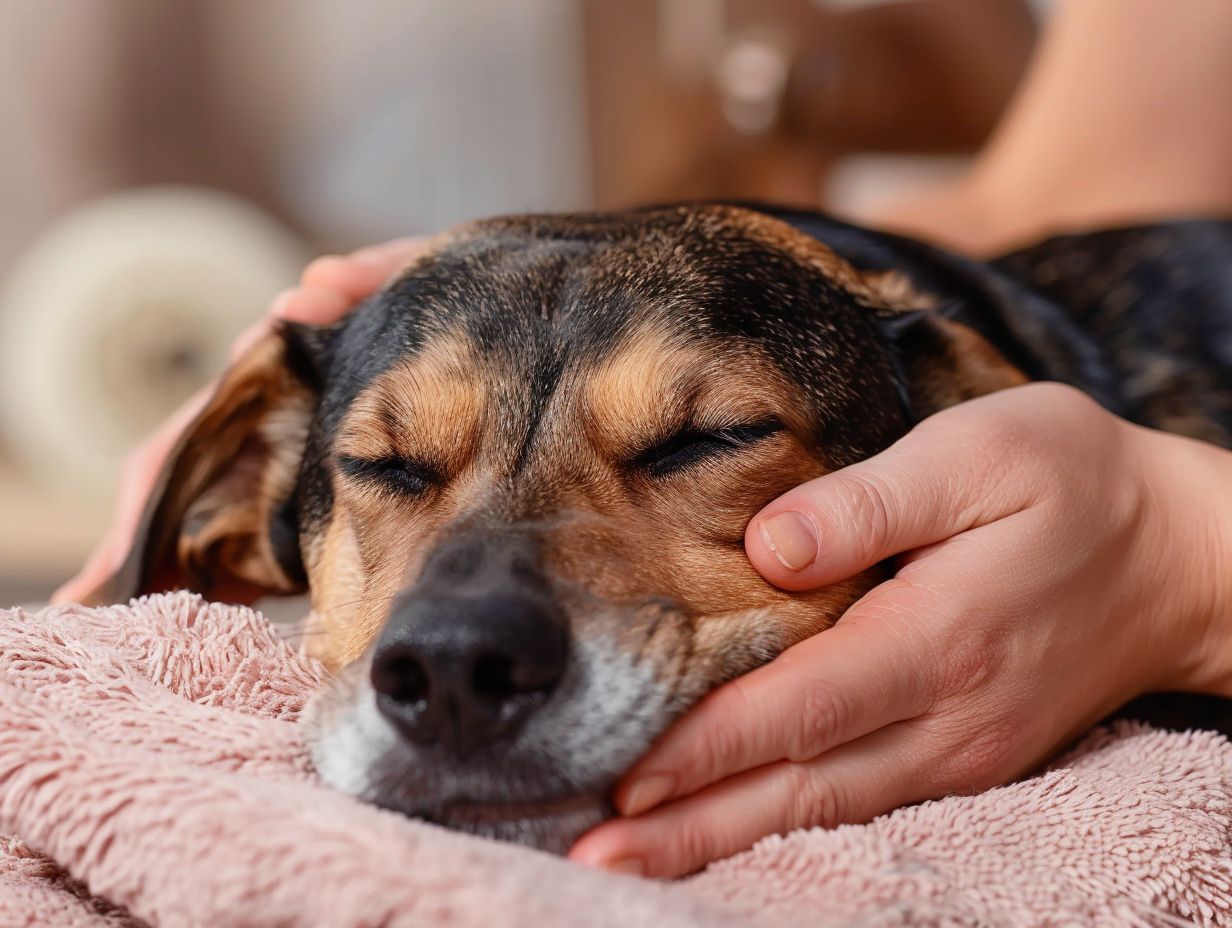
Despite their benefits, essential oils can pose risks to dogs if used improperly. Some oils are toxic to pets and can lead to adverse reactions, including gastrointestinal upset, respiratory issues, or skin sensitivities.
It’s crucial for dog owners to be aware of the potential dangers associated with certain essential oils. For instance, oils like tea tree, cinnamon, and citrus can be highly toxic to dogs due to their chemical compositions.
Using essential oils in excessive amounts or applying them directly without proper dilution can cause harm to your furry friend.
In case of any suspicion of essential oil poisoning, it is advised to seek immediate professional help. Consulting a veterinarian or contacting specialized organizations such as the Pet Poison Helpline can provide guidance on how to handle such emergencies.
What Are the Most Common Essential Oils That Are Safe for Dogs?
Some of the most common essential oils that are safe for dogs include Frankincense, Myrrh, and oils from reputable brands like Rocky Mountain Oils. These oils are known for their soothing properties and minimal adverse effects.
Frankincense oil is useful for promoting relaxation and reducing anxiety in dogs, making it ideal for pets dealing with stress or separation anxiety. Myrrh oil, on the other hand, has antibacterial and anti-inflammatory properties, which can help with wound healing and skin irritations in dogs.
- When using essential oils on dogs, it is crucial to dilute them properly in a carrier oil to avoid skin irritation. A recommended dilution ratio is 1-2 drops of essential oil per 10ml of carrier oil.
- It is advisable to consult with a veterinarian before using essential oils on your dog, especially if your pet has existing health conditions or is pregnant.
- Choosing high-quality oils from reputable brands ensures that the oils are pure and free from harmful additives that could potentially harm your pets.
Can Essential Oils Help with Skin Conditions in Dogs?
Certain essential oils, such as those from Plant Therapy, have been found to help alleviate skin conditions in dogs, including itchiness, inflammation, and dryness. These oils may offer a natural alternative for managing dermatological issues.
For instance, lavender essential oil from Plant Therapy is known for its calming properties, which can help soothe irritated skin and reduce itching in dogs suffering from allergies or hot spots.
Similarly, chamomile oil is renowned for its anti-inflammatory effects, making it a valuable asset in combating skin redness and eczema in canines.
Tea tree oil, when used in diluted form, has been proven to have antibacterial and antifungal properties that aid in clearing up infections and promoting healing of wounds on a dog’s skin.
How Should Essential Oils Be Applied on Dogs?
Essential oils should be applied on dogs through methods such as dilution in carrier oils, diffusion in the environment, or gentle massage. It is crucial to follow guidelines for safe dosages and avoid sensitive areas like the eyes and mucous membranes.
When applying essential oils to dogs, always remember that certain oils can be harmful or toxic to them. It is essential to use oils that are safe for dogs, such as lavender, chamomile, or peppermint. Before using any oil on your furry friend, make sure to dilute it properly to prevent skin irritation. A general guideline is to dilute 1-2 drops of essential oil in 1 tablespoon of carrier oil. Never apply undiluted essential oils directly onto your dog’s skin as it may cause discomfort or adverse reactions.
What Are the Alternatives to Using Essential Oils for Dogs?
For pet owners seeking natural alternatives to essential oils, options such as herbal remedies, flower essences, and soothing balms can provide holistic support for dogs without the potential risks associated with concentrated oils.
One particularly beneficial option is lavender, known for its calming properties in promoting relaxation and reducing anxiety in dogs. Chamomile can be used to aid digestion and alleviate stomach discomfort, while echinacea is valued for its immune-boosting effects. Incorporating these plant-derived products into your pet’s routine can offer a gentle yet effective way to address various canine health concerns.
Natural Remedies
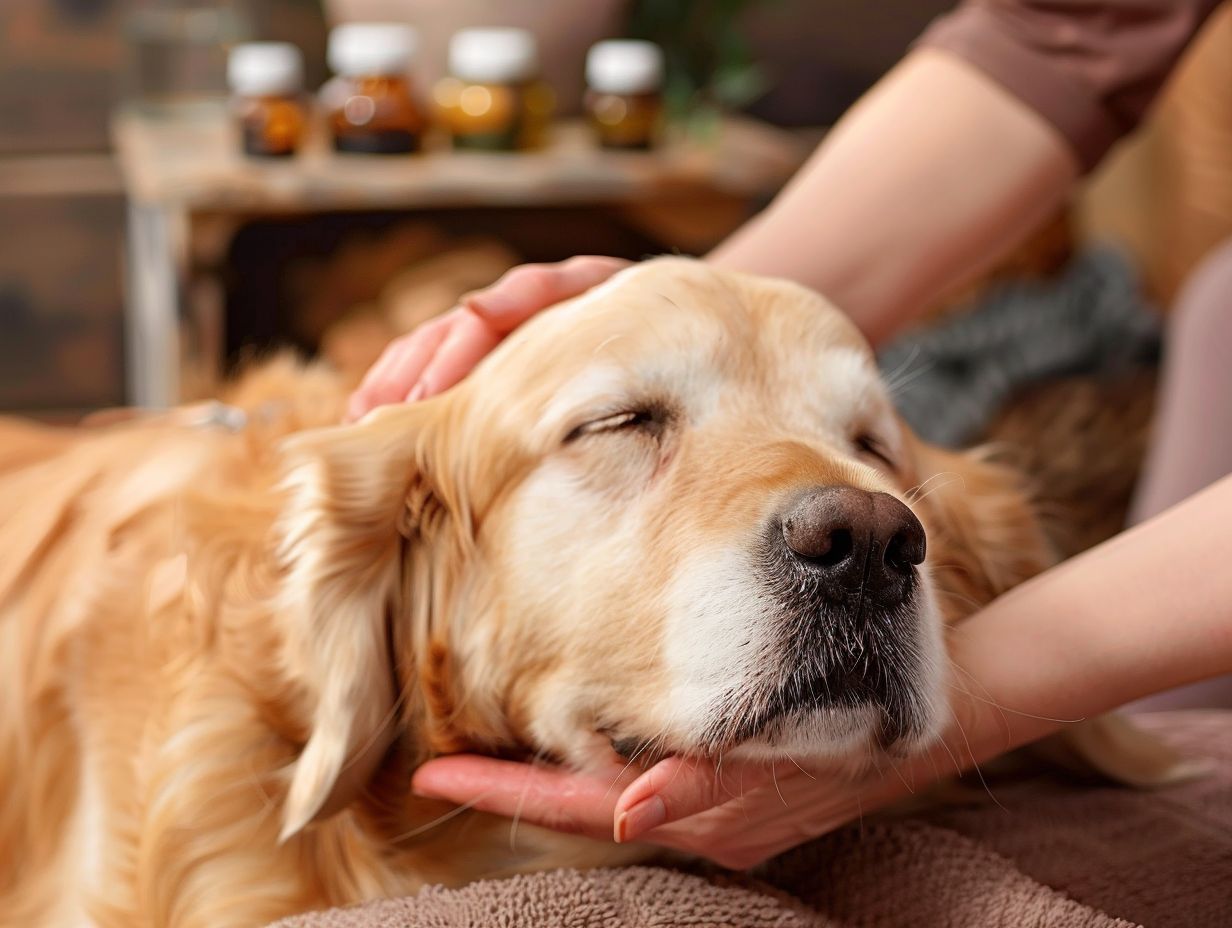
Herbal supplements can be beneficial for digestion, joint health, and anxiety in dogs. They are often made from natural ingredients like turmeric, ginger, and chamomile. Flower essences, such as Rescue Remedy, are popular for calming anxious dogs and reducing stress during fireworks or thunderstorms.
- Plant Therapy’s natural pet care products are well-known for their organic and safe formulations. Their flea and tick repellents, skin soothing balms, and calming sprays are trusted by many dog owners for promoting overall well-being.
Medicated Shampoos
Medicated shampoos designed for dogs can provide targeted relief for skin conditions, itchiness, or dermatitis without the need for essential oils. These products offer gentle cleansing and therapeutic effects for pet skin health.
One of the key benefits of using medicated shampoos for dogs is their ability to combat specific skin ailments like fungal infections or hot spots. These shampoos contain active ingredients such as chlorhexidine or ketoconazole that help in addressing these issues effectively. Medicated shampoos can help in reducing inflammation and soothing irritated skin, making them ideal for pets with sensitive skin or allergic reactions to essential oils. Regular use of these specialized shampoos can also contribute to improving the overall condition and appearance of your dog’s coat, leaving it shiny and healthy.
Dietary Changes
Holistic veterinarians often recommend dietary changes for dogs as a natural approach to address health issues or promote overall well-being. Puppies, in particular, can benefit from balanced and nutritious diets tailored to their growth and development.
Proper nutrition plays a crucial role in keeping dogs healthy and vibrant throughout their lives. Optimal nutrition not only supports their physical health but also contributes to their mental well-being. By providing dogs with high-quality, species-appropriate food, pet owners can enhance their furry companions’ immune system, energy levels, and longevity. Age-appropriate diets for puppies are essential to ensure they receive the right nutrients at each stage of their growth, setting a strong foundation for a healthy adulthood.
What Precautions Should Be Taken When Using Essential Oils on Dogs?
When using essential oils on dogs, it is essential to take precautions such as proper dilution, selecting pet-safe oils, and monitoring for adverse reactions. Brands like Young Living offer animal-specific guidelines for safe oil usage.
Proper dilution ratios are crucial in ensuring the safety of your canine companion. It is recommended to always dilute essential oils not safe for dogs before applying them, as the concentrated form can be too potent and may irritate the dog’s skin or respiratory system. Some essential oils can be toxic to dogs if ingested or applied undiluted, so it’s vital to consult a veterinarian or a pet aromatherapist before using any oils on your pet.
Be vigilant and observe your dog for any signs of adverse reactions, such as excessive drooling, vomiting, or lethargy, which could indicate sensitivity or toxicity. Always opt for reputable brands like Young Living that provide reliable information on pet-friendly essential oil usage.
Dilution
Dilution is crucial when using essential oils on dogs to prevent skin irritation or sensitivities. Proper dosages and dilution ratios ensure the safe application of oils, making them gentle and effective for pets.
Essential oils are highly concentrated natural extracts that can be extremely potent, especially for our furry friends. For dogs, it’s essential to be cautious and meticulous in diluting oils due to their sensitive skin and keen sense of smell. The typical dilution ratio for dogs is 1% to 2% essential oil to carrier oil, to strike the right balance between efficacy and safety. Common carrier oil options include coconut oil, jojoba oil, and olive oil, which help spread the essential oil evenly and reduce the risk of irritation.
It’s important to note that dogs and cats have different dilution requirements when it comes to essential oils. Dogs can generally tolerate a higher dilution than cats, making it crucial to follow specific guidelines for each species. To determine the appropriate dilution ratio, always consult with a veterinarian or a professional in pet aromatherapy to ensure you’re using oils safely and effectively for your furry companion.
Proper Storage
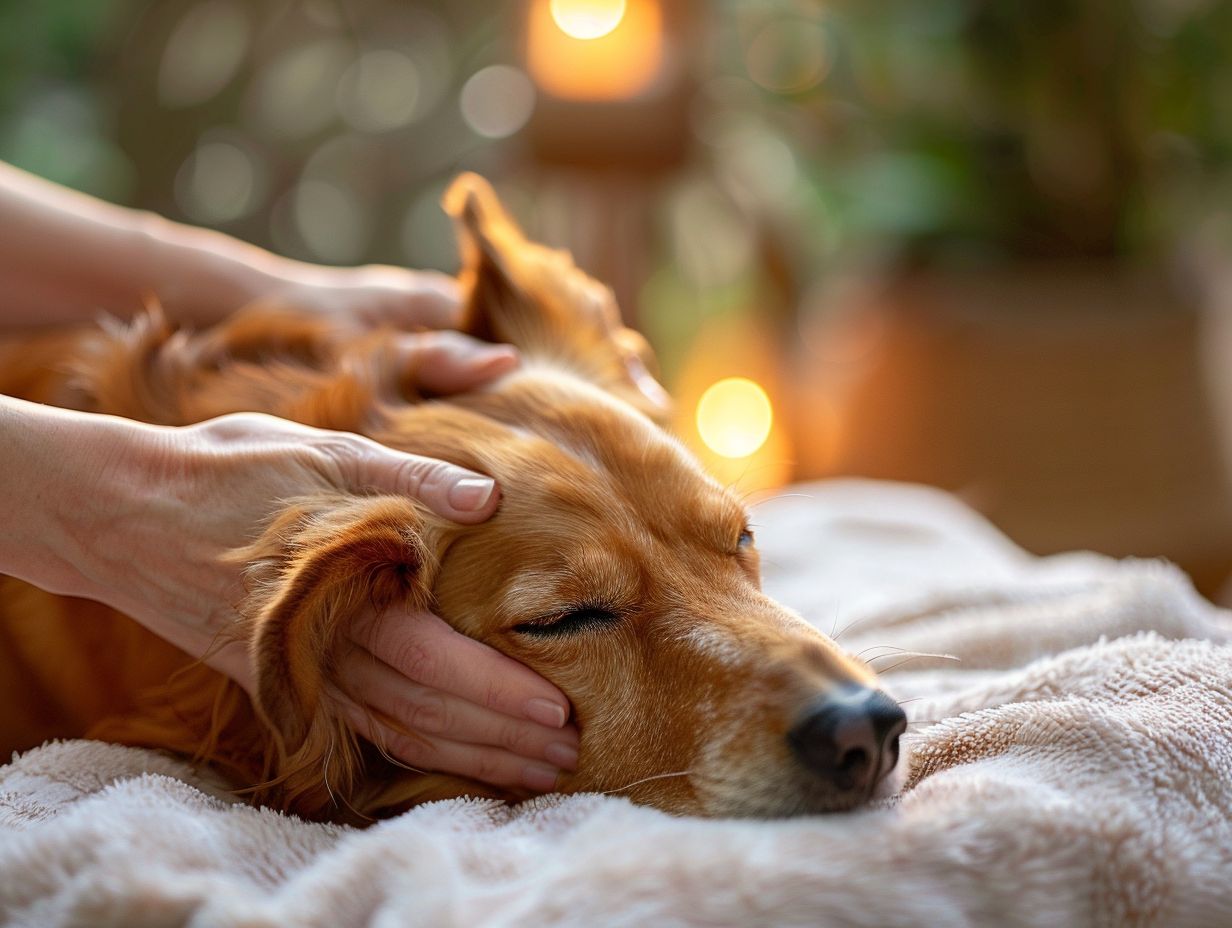
Proper storage of essential oils is essential to prevent accidental ingestion by dogs, which can lead to toxicity. Dr. Katie Woodley recommends storing oils in secure cabinets or areas inaccessible to pets.
It is crucial to remember that dogs are naturally curious creatures and may not hesitate to investigate intriguing scents, such as those of essential oils, if accessible.
Dr. Woodley advises pet owners to opt for sturdy containers with childproof locks to house their essential oil collections and avoid potential hazards from mishaps that could harm their furry companions.
Avoiding Sensitive Areas
When applying essential oils on dogs, it is crucial to avoid sensitive areas such as the eyes, ears, nose, and mucous membranes to prevent irritation or discomfort.
It’s important to understand that dogs have different sensitivities compared to cats when it comes to essential oils. Dogs have a higher tolerance for certain oils, but it’s still essential to dilute the oils and apply them with caution. When using essential oils on dogs, always remember to mix them with a carrier oil to prevent any adverse reactions.
It’s best to avoid using essential oils near wounds, inflamed skin, or areas where the skin is thin and sensitive. Opt for gentle application techniques such as diffusing the oils in the air or applying them to areas with thicker fur.
What to Do If Your Dog Has an Adverse Reaction to Essential Oils?
In case your dog experiences an adverse reaction to essential oils, contact organizations like the Pet Poison Helpline or seek guidance from animal-specific experts such as AnimalEO. Immediate intervention can help mitigate potential risks.
If you notice any signs of distress in your pet after exposure to essential oils, it’s crucial to act swiftly. The first step is to remove your dog from the source of the oils and ensure they are in a well-ventilated area. Next, observe their behavior closely for symptoms like difficulty breathing, excessive drooling, or skin irritation.
- Once you have secured your pet’s safety, call the Pet Poison Helpline or your local veterinary emergency number for immediate assistance. Provide them with details about the essential oils in question and any symptoms your dog is exhibiting.
Additionally, contact your regular veterinarian or an animal poison control expert for further guidance on how to proceed based on your dog’s specific symptoms and health history.
Frequently Asked Questions
Are Essential Oils Safe for Dogs Skin?
Can I use essential oils on my dog’s skin? It depends on the type of essential oil and how it is used. Some essential oils can be harmful to dogs and should never be applied directly to their lavender oils dogs safety. Which essential oils are safe for dogs’ skin? Lavender, chamomile, and frankincense are generally considered safe for dogs’ skin. However, it is important to dilute them properly and check with your veterinarian before use. Are all essential oils safe for dogs’ skin? No, some essential oils can be toxic to dogs and should never be used on their skin. These include vanilla oils.
What precautions should I take when using essential oils on my dog’s skin?
Should I avoid essential oil products marketed specifically for dogs? Not necessarily. While these may be formulated with safety in mind, it is still important to carefully read the ingredients and consult with your vet before use. Are there any signs that my dog may have a negative reaction to essential oils for skin? Yes, if your dog shows signs of skin irritation, redness, or excessive licking or scratching after using essential oils, discontinue use and consult with your veterinarian about essential oils for dogs. Can essential oils be used as a substitute for traditional flea and tick prevention on dogs? No, essential oils should not be used as a substitute for flea and tick prevention products. They may have some repellent properties, but they are not as effective or safe as veterinarian-approved medications.

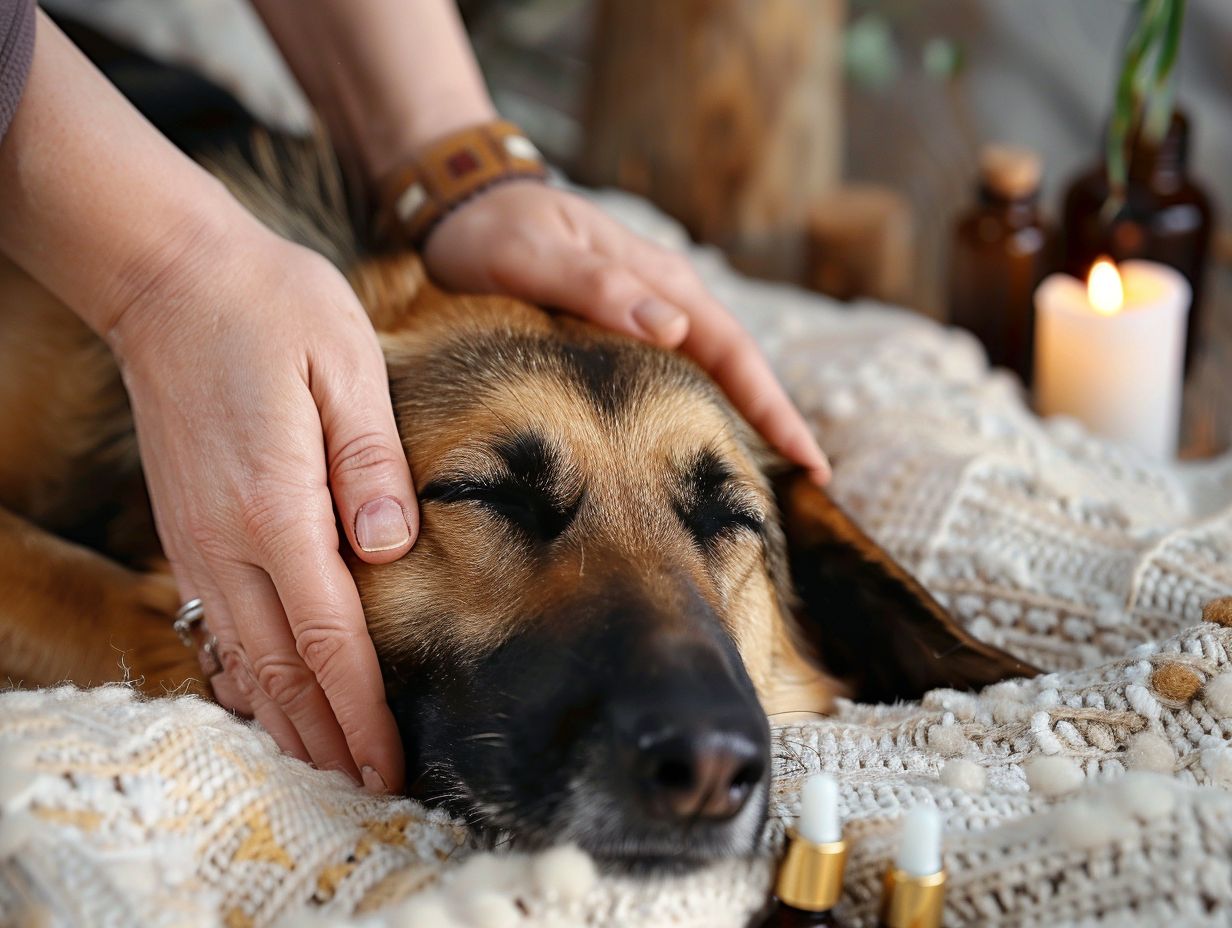




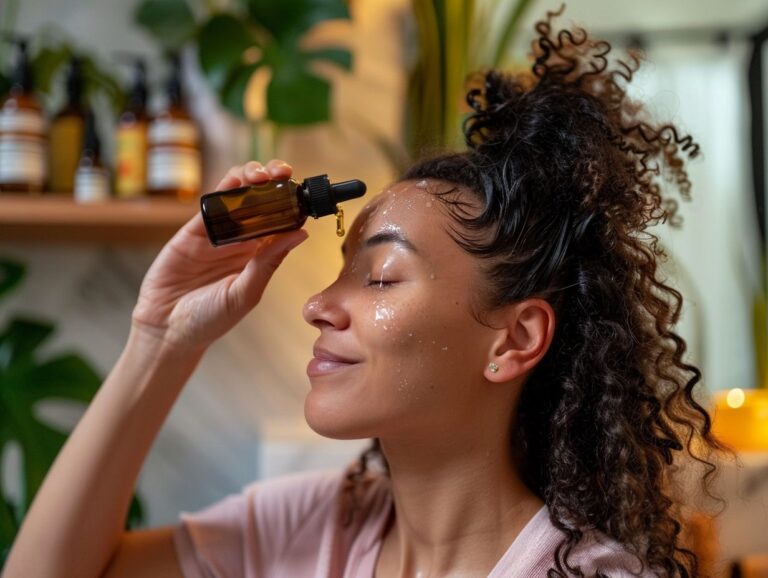

10 Comments